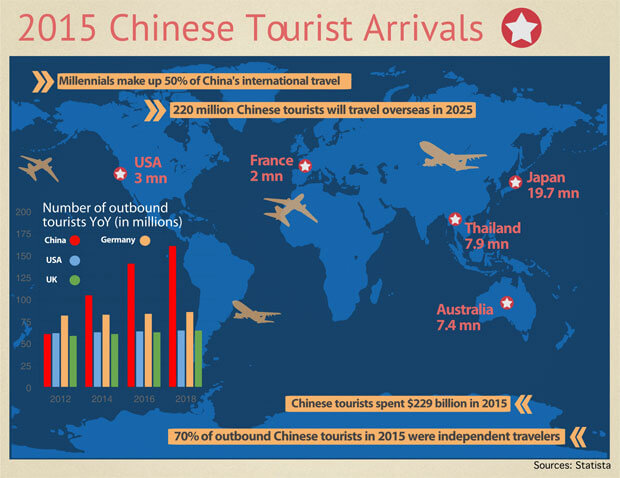US-Asia Business
Preparing Your Business for Chinese Tourist Season
By Melody Yuan

The trend is shifting to self-reliant tourists looking for authenticity and convenience.
“I saved up quite a bit of money to come and visit,” said Ashley Shih, a visitor from Taiwan, at the entrance to Disneyland Park. “I’ve been planning this trip for a while and I can’t wait to explore California.” With her sparkly Minnie Mouse ears and Star Wars backpack, she blended into the crowd of Asian tourists eagerly waiting for the theme park gates to open. Most of them were speaking excitedly in Mandarin.
While the year of the ‘mouse’ has already passed, 2016 promises to be more than just the Year of the Monkey. In fact, Chinese President Xi Jinping and U.S. President Barack Obama have declared it the “U.S.-China Tourism Year” in anticipation of China’s growing rate of outbound tourism.
Driven by a growing middle class and adventure-seeking millennials, outbound tourism in China is set to grow from 150 million in 2015 to 220 million by 2025. The United States alone has seen an annual growth rate of 18.4 percent, with more than 2 million Chinese visitors last year. The collective global retail spending of all Chinese tourists came out to $229 billion last year, and the number is set to continue rising annually. What potential does this hold for U.S. businesses and how can we prepare for the influx of Chinese tourists?

Cater to their Interests
“Unique experiences, great food and authenticity are very important to the modern-day Chinese tourist,” says Charlie Gu, director of China Luxury Advisors. With about 70 percent of Chinese tourists in 2015 identifying as independent travelers, the trend is shifting from the traditional concept of group traveling to more self-reliant globe trotters who prefer to explore their own interests on their own time.
“A significant group of independent travelers are between the ages of 25 and 40 years old, a demographic that’s much younger than other countries’ [tourists],” Gu points out. “They are more adventurous and want to try things outside of their comfort zone. This is really the biggest difference between the new wave of Chinese visitors compared to the old.”
With higher disposable incomes, a number of Chinese visitors have also expanded how much they can spend by exercising greater purchasing power in the form of long-term investments. The Chinese consulate’s 10-year visa program further facilitates the flow of money by allowing the holder of one of these visas to re-enter the United States multiple times. Whether a Chinese visitor comes to purchase real estate or invest in a business, the purpose for their travel goes beyond the traditional definition of tourism.
As these younger Chinese visitors further redefine their idea of wanderlust, how can more anonymous locations and businesses get on their radar screens? “Mass tourists will stay on the beaten track,” says Wolfgang Georg Arlt, director of the China Outbound Tourism Research Institute, “but new Chinese tourists can be attracted to lesser-known places if they’re provided with a good reason to go there.”
The modern Chinese tourist has become more sophisticated, informed and interested in traveling for reasons beyond checking off a list of destinations. Arlt has more advice for businesses: “To attract Chinese visitors, two aspects have to be emphasized: Be the greatest at something in your field, and provide a mix of education and entertainment.”

"New Chinese tourists can be attracted to lesser-known places if they’re provided with a good reason to go there."
Prepare Intelligently
According to The Boston Consulting Group’s analysis, combined domestic and international tourism revenue in China is set to increase 14 percent annually during the next decade. This will mean a roughly $838 billion tourism market, with the majority of the revenue coming from outbound Chinese tourism.
Motivation for outbound travel has shifted to increasingly value authentic experiences over other factors. “What we’re observing here is that the idea of luxury traveling is drifting from purchasing girth to true experiential luxury,” says Gu. “They want to come to America not only to shop for American brands, but to also experience America in a very authentic way.”
Travel agencies are less relied upon among the younger generation. Instead, young people frequently use digital platforms such as Ctrip.com International Ltd., Qunar Cayman Islands Ltd. and WeChat as they plan their trips abroad. The range of Chinese websites and social media platforms can be difficult, expensive and time consuming for foreign brands and companies to navigate. Because of this, Gu believes that smaller businesses should focus more on ways to remain authentic and welcoming once the Chinese have arrived, and to encourage positive word of mouth rather than trying to make an online presence in China’s saturated digital market.
“You should be prepared,” Gu instructs. “You don’t need a whole marketing campaign in China. Start with smaller adjustments that could make their stay convenient.” Taking steps like setting up a UnionPay International or an Alipay.com account, and having a Chinese-speaking staff or materials in Chinese readily available, can leave an incredibly positive impression. Working with local destination management organizations and tourism boards to leverage more grassroots business is also a practical solution to appearing on Chinese visitors’ radar.
Growing ‘Guanxi’
The one constant that has withstood the test of time is the Chinese tourist’s appreciation of “guanxi,” or relationships, which can be built during a visit and cultivated over time. Hong Kong was once the city of choice for outbound Chinese tourists, with a plethora of shopping options. Traveling to Hong Kong offered lower costs, shorter distances and cultural familiarity. By the start of November 2015, however, the most-preferred destinations for Chinese travelers have expanded to include South Korea, Thailand, Japan and Taiwan. Although the Chinese are increasingly pursuing unique adventures, they are still drawn to meaningful experiences.
"Food is the age-old connecting agent in Chinese culture and has become the No. 1 inspiration and motivation for traveling"

Authenticity can be proven and further reinforced through personalization. A restaurant, for example, can leverage food to create dishes that are rare and representative of its local area. “Dining is an area that has captured a lot of the new growth,” says Gu. “Food is the age-old connecting agent in Chinese culture and has become the No. 1 inspiration and motivation for traveling.” While having the comfort of Chinese food is desirable, travel organizations such as China Luxury Advisors and the Los Angeles Tourism & Convention Board have noticed that Chinese visitors are increasingly dining out at Michelin star restaurants or more local restaurants to get a taste of something different. Translated menus, offering the option of tea in addition to coffee, and even having a description of the dishes on the menu are all vital ingredients for establishing “guanxi” with Chinese tourists while demonstrating authenticity.
As the U.S.-China Tourism Year progresses, businesses should note Chinese outbound tourism is projected to continue growing. Investing in ways to prepare efficiently for Chinese tourists is not only a strategic business move; it will also help boost the overall attractiveness of the destination in which the business operates.
Sign up for the Reach Further Newsletter
We’ll keep you in the know about the latest US-Asia business news and trends.
Suscríbase al boletín Reach Further
Lo mantendremos informado sobre las últimas noticias y tendencias comerciales entre Estados Unidos y China.

